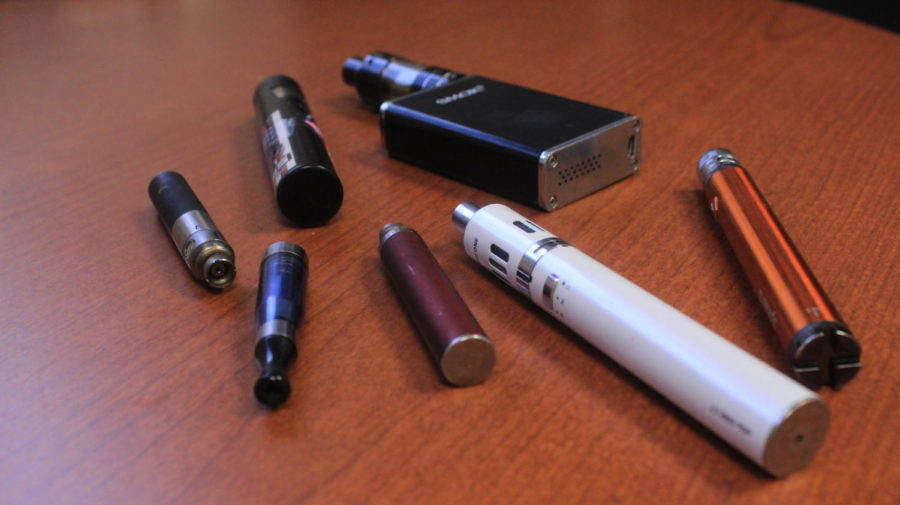To Vape Or Not To Vape
November 21, 2017
E-cigarette smoking, commonly called vaping, is a relatively new practice that is rapidly gaining momentum.
Vaping involves inhaling the vapor released when a combination of vegetable glycerin, propylene glycol, and nicotine is burned in an electronic nicotine delivery system (ENDS), commonly called a “vape pen.” A newer, smaller variety, the Juul, is another device that is gaining popularity.
Vaping appears to be extremely popular here at Wheat Ridge High School, particularly according to multiple admitted student vapers, among the freshman population. However, it is very hard to obtain any real information on the subject because the school has banned nicotine use of any kind anywhere on campus. Estimates by students and staff of the numbers of E-cigarette users at Wheat Ridge High range from 10% to 50% however, there is no real data on the subject. You can’t exactly take a survey: “Do you vape? Check yes or no.”
One thing that can be confirmed is that there are two or three “busts,” or people getting caught vaping, or at least in possession of nicotine, each day here at school.
Nicotine use is illegal anywhere on campus. As a result, people go to the bathroom to vape, and are caught there by security or the administration. The first time being caught is a warning, after that is a two day suspension. Students who get caught may also have to do community service in addition to, or, instead of getting suspended. Whether caught actually vaping or simply in possession of nicotine delivery devices, the student’s nicotine and delivery systems a student has will be confiscated and only returned if their parents come to pick it up.
One of the most popular reasons for vaping is to help the user to stop smoking cigarettes. Both admitted “vapers” and medical personnel agree that this is not the case. “You just end up getting hooked to both,” said one Wheat Ridge student. According to the U.S. Food and Drug Association (FDA), there are seven medicines approved for smoking cessation: transdermal nicotine patches, nicotine gum, nicotine lozenges, nicotine nasal spray, nicotine oral inhalers, varenicline (Chantix), and bupropion (Zyban). E-cigarettes didn’t make the cut.
Another main reason students begin vaping is because it relieves stress. “It really eases up my anxiety,” a student explained. While this may be true on the outside, inside the human body, this is not the case. In the brain, the areas that are responsible for feelings of pleasure and reward are activated by the nicotine molecules. So while a nicotine user experiences a pleasurable feeling, it is not actually “real” happiness, simply an artificial increase of dopamine, the pleasure molecule in the brain. This pleasurable feeling produced with each “hit” of nicotine could be the reason that it is so hard for people to stop smoking.
Of course, peer pressure is also an extremely prevalent rationale for starting to vape. Because it’s a newer practice, the people who vape are perceived as cool by the majority of adolescents, making this a contributing factor.
Because vaping is a relatively new fad, there is little scientific evidence about it. According to the U.S. Department of Health and Human Services (HHS), since ENDS do not involve inhaling actual smoke, many of the cancer causing carcinogens and tars present in cigarettes are not present in vape pens. However, they add that using ENDS such as vape pens does have risks, as they still do contain dangerous substances, such as nicotine, heavy metals, ultrafine particulate, and cancer-causing agents like acrolein.
While ENDS do contain dangerous substances, such as the heavy metals and ultrafine particulate, by far the most disturbing hazard in vaping is the nicotine added in the vape juice. Nicotine is a colorless, poisonous, nitrogen-containing chemical that is highly addictive. According to Psychology Today, nicotine is one of the most heavily used addictive drugs in the country. Scientific studies show that nicotine use during adolescence can “disrupt the formation brain circuits that control attention, learning, and susceptibility to addiction,” as reported by the HHS. While you can make vape juice without the nicotine (simply a combination of vegetable glycerin and vanilla), nicotine is of course the most attractive ingredient to most “vapers.”
Vaping remains the controversial pastime that it was when it first introduced to the mass market in 2007. The difference is that now, it is gaining popularity. While it is difficult to know exactly how many students vape, it goes without saying that there are a lot of them. While the HHS lobbies for laws limiting sales and prohibiting marketing and sales, and the E-cigarette companies come up with more ingenious disguises for vape pens (making them look like pens, lead cases, etc.), high school students continue to vape despite the school’s regulations and penalties.

